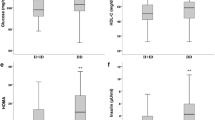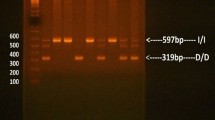Abstract
The deletion (D) allele of the angiotensin-converting enzyme (ACE) gene insertion/deletion (I/D) polymorphism has been shown to be associated with cardiovascular and renal diseases in diabetes mellitus, but the mechanism underlying this association is not known. In addition, recent studies of the effect of the ACE gene on blood pressure have yielded conflicting results. Therefore, we studied the association of the ACE gene I/D polymorphism with glucose intolerance and insulin resistance, and the contribution of this locus to genetic susceptibility to hypertension in non-insulin-dependent diabetic mellitus (NIDDM). We analysed the ACE genotype in 84unrelated NIDDM patients with a known disease duration of less than 1year and in 115age- and sex-matched controls. The I/D polymorphism was determined by the polymerase chain reaction. There were no differences in ACE genotype distribution and allele frequencies between patients with NIDDM and nondiabetic controls. The frequencies of the D and Ialleles in both groups were identical, viz., 0.65 and 0.35, respectively. The NIDDM patients with the DD genotype had significantly higher blood glucose levels in the oral glucose tolerance test than those with the other genotypes; the incremental glucose area under the curve in the order of II, ID, and DD was 7.2 ± 2.4, 9.2 ± 4.0, and 10.7 ± 2.7mmol/l · h (II vs ID vs DD, P=0.0066 by ANOVA). No significant difference was found between the ACE genotype and serum insulin values. Similarly, there were no differences in body mass index, blood pressure, or serum lipids between the three genotypes. Among the nondiabetic controls, there was no statistically significant association of the I/D polymorphism with serum lipids, blood glucose levels, serum insulin concentrations, or blood pressure values. In conclusion, NIDDM patients with the DD genotype have higher blood glucose levels and are more glucose intolerant; this may help to explain the reported association between the Dallele and vascular complications in NIDDM.
Similar content being viewed by others

Author information
Authors and Affiliations
Additional information
Received: 15 September 1997 / Accepted: 13 November 1997
Rights and permissions
About this article
Cite this article
Huang, XH., Rantalaiho, V., Wirta, O. et al. Relationship of the angiotensin-converting enzyme gene polymorphism to glucose intolerance, insulin resistance, and hypertension in NIDDM. Hum Genet 102, 372–378 (1998). https://doi.org/10.1007/s004390050707
Issue Date:
DOI: https://doi.org/10.1007/s004390050707



